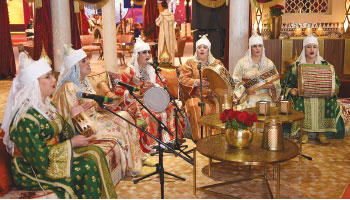 During “Morocco in Abu Dhabi”, Moroccan artists are enchanting attendees from Abu Dhabi and across the UAE with an array of musical pieces offering a beautiful mix of popular folklore music and heart-warming vocals, with daily performances between 3pm and 9pm at the Abu Dhabi National Exhibition Centre.
During “Morocco in Abu Dhabi”, Moroccan artists are enchanting attendees from Abu Dhabi and across the UAE with an array of musical pieces offering a beautiful mix of popular folklore music and heart-warming vocals, with daily performances between 3pm and 9pm at the Abu Dhabi National Exhibition Centre.
The music performances highlight the authenticity of Moroccan music, blending the country’s history and original heritage, and are performed by world renowned musicians and artists presenting shows with music styles from across Morocco, including Chefchaouen cultural music, Al Hassani songs, the Art of Malhoun and the Andalusian Tarab, amongst others.
Music is richly spread across the Kingdom of Morocco and many cities are characterized by their own unique styles of music; for instance, Fes is famous for Gharnati (Granada) music, the south is home to several Amazigh bands, and the Meknes region is known for Gnawa and Essaouiran music.
The performances at “Morocco in Abu Dhabi” will include a variety of traditional music from Chefchaouen cultures and Moroccan poetry set to music with Laila Albourak, Aicha Doukali and her Art of Malhoun Band, Al Hassani songs and Al Qudra dance, Abdullah Al-Makhtoubi’s musical pieces and the Andalusian Tarab, as well as Maalem Bakbou and the Gnawa Band, Raisa Tahehit Show and her Amazigh band, Bayane Belayachi and the Gharnati Music Band along with a selection of pieces performed by musicians and bands throughout the day.
While The Chefchaoueni Hadra art was usually limited to performances in houses and concert halls during weddings and special events, we can now see this style gaining greater fame within Morocco and in the Moroccan diaspora, and is named after the famous ‘blue’ city of Chefchaouen.
The art of Malhoun is a masterpiece combination of poetry recital and singing which originated in the cities of Tafilalet, Marrakech, Fez, Meknes and Salé, and then spread across Morocco. It is an ancient musical and recitation heritage that brings together Moroccan-Amazigh and Andalusian cultures.







